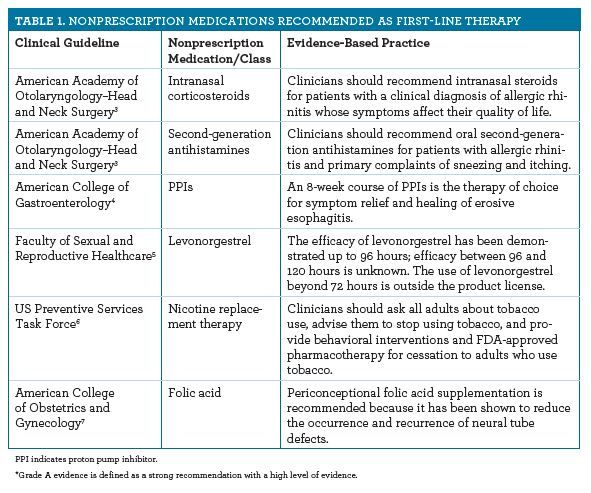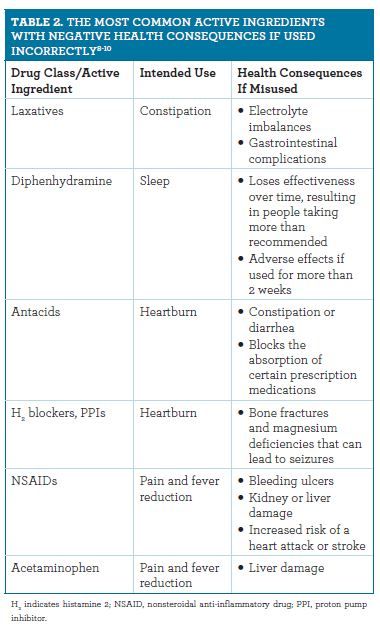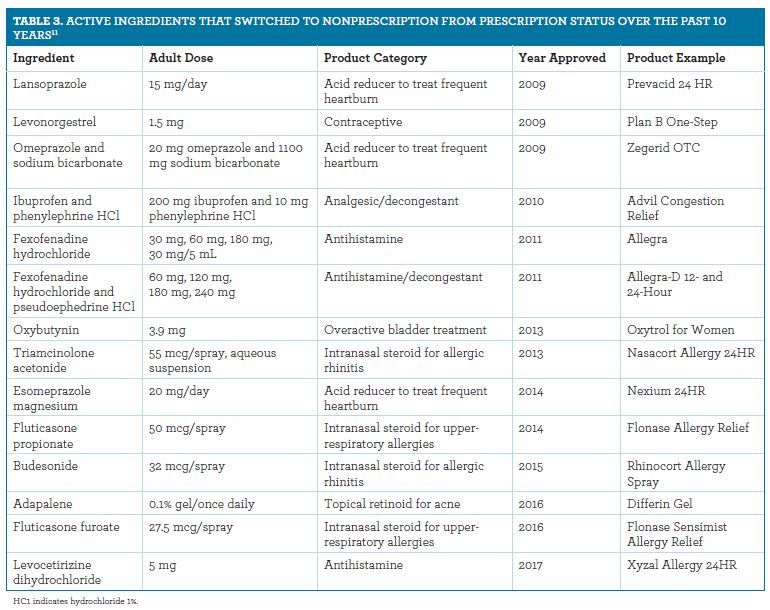Publication
Article
Pharmacy Times
Nonprescription Medication Trends
Author(s):
Nonprescription medications provide $102 billion in value to the US health care system annually.
Nonprescription medications provide $102 billion in value to the US health care system annually. Of this, $77 billion is from clinic office visit savings, and $25 billion is the result of drug savings.1 These also play an increasingly vital role by providing easy access to certain drugs that can be used safely without the help of a health care practitioner. This allows consumers to take control of their own health care in many situations. Four of 5 American adults commonly take nonprescription medications, most often to treat acute ailments. The top sales categories in 2016 were analgesics, heartburn, upper respiratory, first aid, and toothpaste, according to data from the Consumer Healthcare Products Association.2 Because of consumer demand and the accessibility of pharmacists, pharmacists typically get many questions from patients about the safety of these products. As with prescription products, the FDA evaluates and reviews nonprescription products. Nonprescription drugs generally have the following characteristics:
- Their benefits outweigh their risks.
- The potential for misuse and abuse is low.
- The consumer can use them for self-diagnosed conditions.
- They are labeled adequately.
- Health practitioners are not needed for the safe and effective use of the products.
Several nonprescription medications are recommended as first-line therapy, according to clinical guidelines. Table 1 lists the common medications and support for their use.

Misuse of Nonprescription Medications
As health care plans shift to reduce costs, the use of nonprescription medications will increase. Because of this, pharmacists will become even more essential to educating patients about appropriate use. There are more than 100,000 nonprescription products on the market and more than 1000 active ingredients from which to choose. This does not count the numerous dietary supplements, vitamins, and non—FDA-approved products sold in pharmacies. This can be overwhelming to a patient who is seeking self-treatment. Pharmacistsmust help patients use these products safely. When used appropriately, nonprescription medications are effective and safe. Their convenience and cost make them appealing to most consumers who need treatment. However, 1 in 5 adults who self-medicates admits to taking more than the recommended dose or using the medication more frequently than the label indicates. Very few of these adults consult a doctor or a pharmacist about the appropriate use of a nonprescription medication. Pharmacists should promote themselves as OTC experts and persuade consumers to seek their advice.
Given that the use of nonprescription drugs is going to continue to rise, it is important for pharmacists to know which nonprescription drugs are most commonly abused, whether intentionally or unintentionally. Table 2 lists the most common active ingredients with negative health consequences if used incorrectly.8-10

Prescription-to-Nonprescription Switches
Many available nonprescription products were previously available only with a prescription. Since 1976, there have been 114 active ingredients that switched to nonprescription from prescription status. The switches for the past 10 years are listed in Table 3.11

Thanks to these switches, families can conveniently buy and use a wider range of treatments without having to go to the doctor. Access and affordability are the 2 most common attributes touted by consumers and our nation’s health care system. Seven of the past 14 switches are in the allergy category. Data from the Consumer Healthcare Products Association show that the number of allergy sufferers who use OTCs rose to 75% in 2015, from 66% in 2009.11 Other statistics show that anytime a switch is made in a new product category, use within that category increases. Consider the following:
- There was a 150% to 200% increase in the purchase and use of nicotine replacement therapies in the first year after the switch. Increased access enabled tens of thousands of smokers to use these products to help quit smoking and live longer, healthier lives. That is a $2 billion social benefit every year. The nicotine replacement therapy switch led to 650,000 extra quit attempts.
- Consumers saved an average of $174 per year in avoided prescription costs and office visits for heartburn medicines. This additional access also drove $750 million in savings for the health care system.
- After vaginal yeast treatments were made available over the counter, results from studies showed that women were as accurate as their doctors in recognizing the recurrence of such infections.
These statistics demonstrate the continued need of pharmacists to be aware of prescription-to-nonprescription switches so that we can best educate patients. As pharmacists, we must be aware of which populations should use these medications and which require additional education.
Special Population Considerations
Although nonprescription medications are effective and safe when used appropriately, pharmacists must pay extra attention to special groups, such as elderly, pediatric, and pregnant patients, as well as those with coexisting comorbidities. These patients require additional education to ensure that the nonprescription medications are suitable for them. For example, patients older than 65 are most likely to have health issues that may contraindicate the use of certain medications, yet older adults account for about 40% of nonprescription medications consumed. These older adults face the greatest risk of adverse effects and drug interactions. Drug-related adverse events faced by older patients include confusion, depression, falls, hallucinations, and malnutrition. People who routinely take 1 or more prescription drugs or who have underlying health problems, such as those with asthma; chronic obstructive pulmonary disease; clotting disorders; diabetes; an enlarged prostate; epilepsy; glaucoma; gout; high blood pressure; immune system, kidney, or liver problems; Parkinson disease; psychiatric issues; or thyroid problems, should receive counseling from a pharmacist prior to taking a nonprescription medication. Pediatric patients are another population at increased risk for unintentional misuse. Pediatric dosing errors may be due to the use of inappropriate measuring devices, the wrong dosage form, inappropriate medication techniques, or age-based dosing. This is another area of opportunity for pharmacists to provide more education about the appropriate and safe use of nonprescription medications.
Conclusion
Nonprescription medications can be effective and safe if taken correctly. Pharmacists need to take the lead in preventing and identifying intentional and unintentional misuse as well as understand where nonprescription medications fit into therapy so we can encourage safer and smarter use of these medications.
Stefanie Ferreri, PharmD, BCACP, is a clinical professor at the University of North Carolina Eshelman School of Pharmacy, in Chapel Hill.
References
- Booz & Co. The value of OTC medicine to the United States. yourhealthathand.org/images/uploads/The_Value_of_OTC_Medicine_to_the_United_States_BoozCo.pdf. Published January 2012. Accessed January 3, 2018.
- Consumer Healthcare Products Association. OTC sales by category 2013-2016. chpa.org/OTCsCategory.aspx. Accessed January 3, 2018.
- American Academy of Otolaryngology. Clinical practice guideline: allergic rhinitis. wwwentnet.org/content/clinical-practice-guideline-allergic-rhinitis. Accessed January 3, 2018.
- National Guideline Clearinghouse. Guidelines for the diagnosis and management of gastroesophageal reflux disease. guideline.gov/summaries/summary/43847/guidelines-for-the-diagnosis-and-management-of-gastroesophageal-reflux-disease. Published March 2013. Accessed January 3, 2018.
- National Guideline Clearinghouse. Emergency contraception. guideline.gov/summaries/summary/38434/emergency-contraception?q=emergency+contraception. Published September 2012. Accessed January 3, 2018.
- Siu AL. Behavioral and pharmacotherapy interventions for tobacco smoking cessation in adults, including pregnant women: U.S. Preventive Services Task Force recommendation statement. Ann Intern Med. 2015;163(8):622-634. annals.org/aim/article/2443060/behavioral-pharmacotherapy-interventions-tobacco-smoking-cessation-adults-including-pregnant-women. Accessed January 3, 2018.
- National Guideline Clearinghouse. Final recommendation statement: folic acid for the prevention of neural tube defects: preventive medication. guideline.gov/summaries/summary/50619/final-recommendation-statement-folic-acid-for-the-prevention-of-neural-tube-defects-preventive-medication?q=neural+tube+defects. Published January 2017. Accessed January 3, 2018.
- National Institute on Drug Abuse. Commonly abused drugs charts. drugabuse.gov/drugs-abuse/commonly-abused-drugs-charts. Updated July 2017. Accessed January 3, 2018.
- National Institute on Drug Abuse. Drugs of abuse. drugabuse.gov/drugs-abuse. Accessed January 3, 2018.
- Cooper RJ. Over-the-counter medicine abuse - a review of the literature. J Subst Use. 2013;18(2):82-107. doi: 10.3109/14659891.2011.615002
- Consumer Healthcare Products Association. Rx-to-OTC switch. chpa.org/Switch.aspx. Accessed January 3, 2018.







